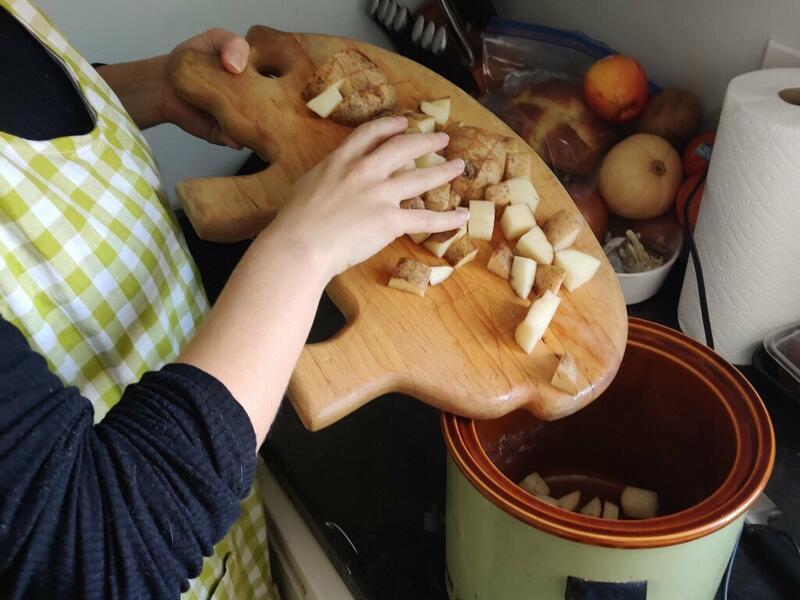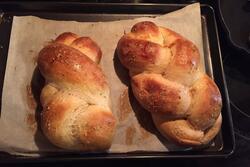Love Your Crockpot? You Have Cholent to Thank for its Existence.
When I think of crockpots, my mind doesn’t go immediately to Jewish cooking. Growing up, crockpots were things that nice church ladies pulled out to make chili for potlucks or to heat up nacho cheese at sporting events. There was always something distinctly American about bubbling sludge cooking for hours in electric pots that seemed to come straight out of Country Living magazine. In my own house, we had an ancient crockpot that my father would pull out once a year to make soup for his office Christmas party, and half the time it wouldn’t even work.
I didn’t really discover the wonders of a crockpot until late last year, when I sat down to find a recipe for cholent, a Jewish stew traditionally eaten for Shabbat lunch. I had never made cholent before, but I quickly fell down a rabbit hole of cholent production. I wanted to know its history, its variations, its cultural importance. Lo and behold, I discovered that the crockpot, the easiest way to make cholent, is a staple in many Jewish homes—and has a distinctly Jewish past.
I grew up in a rather ritually lax, culturally Jewish household. While my mom would make brisket at the holidays, tzimmes at Rosh Hashanah, and latkes at Hanukkah, that was the extent of our Jewish food consumption. In more observant families, cholent (and the crockpot) is likely much more familiar, particularly to those who observe Shabbat. Consisting of vegetables, beans, and meat, cholent is an Ashkenazi dish that dates back at least to the twelfth century. Variations of the diesh exist all overthe world. Sephardim might be more familiar with chamim, dafina, or skhina, for example.
The brilliance of cholent is that the slow-cooked dish allows observant Jews to have a hot lunch on Shabbat without breaking any Jewish laws regarding work on the holy day. You can prepare your cholent on Friday, before Shabbat begins, and the stew will cook slowly overnight, ready for eating the next day. In the medieval and early modern periods, families would fill an earthenware pot with their cholent ingredients on Friday evenings, and then, on their way to shul, drop the pots off at the local baker’s shop, where they would sit in the communal ovens overnight. The following day, families could pick up their pots on the way home from shul and have a filling meal ready to eat.
Skipping ahead a few centuries, the crockpot is what most Jews use make cholent. But actually, the connection between cholent and the crockpot is even more direct. In the early twentieth century, a recently widowed Jewish immigrant named Tamara Kaslovski Nachumsohn moved to Winnipeg, Manitoba with her children, Sadie and Irving. There, Irving studied electrical engineering and eventually became one of the first Jewish engineers in the United States.
Irving had grown up hearing about his mother’s life in Vilna, Lithuania, and in particular, how she would drop off her pot of cholent at the local baker’s oven every Friday afternoon. Inspired by these stories, Nachumsohn invented the first slow cooker in 1936. It was another fourteen years before the slow cooker was sold to the public, under the name “the Naxon Beanery.” (Nachumsohn chose to anglicize his name for marketing purposes.)
It was not until 1970, when Nachumsohn sold his company to Rival Manufacturing, that the invention was dubbed the “crockpot.” While the crockpot was advertised to all women in the United States, its original intent was for making cholent. Essentially, without cholent, there’s a chance the crockpot would never have been invented.
And was that invention ever important, particularly for women. The crockpot revolutionized cooking for married women—in fact, it was marketed as a way for women to go to work and still have a hot meal waiting for their families at the end of the day. All they needed to do was turn on the pot before leaving the house in the morning. As a modern working woman myself, I can confirm that the ease of using a crockpot still holds true (although my partner is more likely to do the cooking than I am), and coming home to a hot meal at the end of the day can’t be beat.
While I use my own crockpot to make a variety of stews, there’s nothing I love more than making cholent, especially as we head into the cold of fall and winter. The dish is delicious in itself, but my favorite part of cooking the dish is thinking about how generations of Jewish women have been making cholent, across time and space. Countless hands over the centuries have chopped potatoes and carrots and onions and beef and tossed them into the cholent pot. When I’m making cholent, I’m but one of many Jewish women, and that’s the most comforting part of the dish.
I’ve included my own recipe for cholent below. A couple of notes: Most importantly, there’s no right way to make cholent. Everyone has their own twist, whether that be the types of spices they add or the vegetables they choose to include. If you want to add other vegetables, like carrots, sweet potatoes, or squash, go for it! Many recipes include kishka as well, and Sephardic versions may include chicken or eggs. This recipe is meant to give you some basic building blocks so you can take the recipe and make it your own. Also, it’s very easy to make this into a vegan dish. Just leave out the meat! You can substitute in more vegetables or more beans (or both) and use vegetable broth instead of beef.
As we head into the colder months, I’ll be making this recipe more and more. I hope you’ll find that cholent warms up your cold days as much as it does mine.
Ingredients:
- 2 medium sized potatoes, cut into 1-inch chunks
- 1 yellow onion, roughly chopped
- 8 oz mushrooms, sliced
- About 1 lb of boneless beef short ribs, or beef stew meat
- ¾ cup dry barley
- 1 cup dry beans (I like to use a few different kinds of beans; for example, ½ cup kidney beans and ½ cup cranberry beans. Lima beans and navy beans are also commonly used.)
- 3 cups broth (vegetable or beef)
- 2–3 tbsp smoked paprika
- 1 tsp paprika
- 1 tsp garlic powder
- 1 tsp black pepper
- ½ tsp chili powder
- ½ tsp turmeric
- ½–1 tsp salt (if you’re using kosher meat, your beef will already be a bit salty, and you should stick to the lower end of the spectrum)
- 2 tbsp honey or brown sugar
- 2–3 cups of water
Directions:
- In a crockpot, layer in the potato chunks, onion, mushrooms, followed by the beef. Sprinkle in one teaspoon of the smoked paprika, the black pepper, the garlic powder, the chili powder, the turmeric, and a pinch of salt.
- On top of the beef, add the barley and the beans. Pour in the vegetable or beef stock.
- Add another 2 tablespoons of the smoked paprika, the regular paprika, the rest of the salt, and the honey or brown sugar. Give the mixture a quick stir.
- Pour water over all the ingredients so that everything is submerged in liquid; you don’t want the ingredients to dry out while they’re cooking. Two cups should be enough, but you may need extra depending on how much beef you’ve added.
- Turn your crockpot to low heat and cook for at least 12-15 hours. Don’t be afraid to let it cook longer —most of the water should be absorbed by the time it’s finished, and the longer the cholent cooks, the more flavorful it will taste.








I actually bought a slow cooker to do this. It was perfect, smoked paprika works wonders. Thanks!
Wonderful essay! Thank you. Will try your recipe, Savoy.
Great article! I never knew the origin of the crockpot